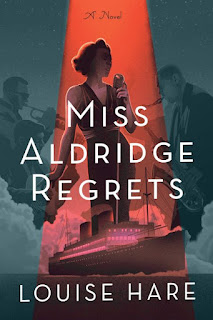Louise Hare is the author of the new novel Miss Aldridge Regrets. She also has written the novel This Lovely City. She is based in London.
Q: What inspired you to write Miss Aldridge Regrets, and how did you create your character Lena Aldridge?
A: I had to write a short story while I was studying for my Masters in Creative Writing. That semester we were looking at genre fiction and I decided to write a historical crime story set in a Soho jazz club in 1950. The problem was that the story never quite felt finished – people wanted to know what happened to the main character afterwards and this novel tells that story.
I changed the period to the 1930s because I love watching the TV adaptations of Poirot (David Suchet’s version specifically). I wanted to recreate the glamour and I felt as though politically there were a lot of interesting parallels between our current time and back then…
Lena’s character emerged from the idea that when we see a confident performer on stage, we tend to feel that they must have everything figured out. I wanted to write a character who can project a false image of themselves, but also still be sympathetic.
Q: How did you research the novel, and did you learn anything that especially surprised you?
A: I read a lot of books about the history of the 1930s, what life was like in the UK back then and Soho in particular.
I also found a wealth of information about the Queen Mary. She was such an iconic ship that a lot of books were published about her, including a really useful book called The Queen Mary: Her Early Years Recalled by C.W.R Winter. He was a crew member who worked on the ship in the 1930s and his stories bring the ship to life.
I was especially surprised to learn that alongside the celebrities and wealthy passengers, first class was also home to professional prostitutes and gamblers who travelled back and forth across the Atlantic and made a lot of money out of their fellow passengers!
Q: The book takes place along two timelines: on the Queen Mary, and also in London a week earlier. Did you write the novel in the order in which it appears, or did you focus more on one timeline before turning to the other?
A: My previous novel had a similar structure, with two timelines, and so I had learned a lot about how not to do it this time around! I wrote the two timelines separately, although I sometimes alternated between them. Once I was happy with the Soho timeline, which is shorter in terms of the word count, I figured out where it fit in-between the main timeline.
Q: What do you think the novel says about racism in the United States and England in the 1930s?
A: Essentially, my research seemed to confirm that racism in the US and the UK (similar to today, if I’m honest) mostly differed in terms of how explicit it was.
In the US there was a clear colour bar and explicit laws about how Black people could live their lives and where they could go. Technically in the UK there were no laws in place, but if you were Black and were discriminated against, which was common, there was nothing you could do.
In the novel Lena goes to the Savoy hotel in London, passing as white, and she recalls that a few years earlier the famous African American actor Paul Robeson was turned away from the restaurant there so that he didn’t “upset fellow American guests,” even though he was starring in the theatre next door!
Q: What are you working on now?
A: A sequel! Of course, the murderer is unveiled at the end of the novel, but Lena’s story isn’t over…
Q: Anything else we should know?
A: If you enjoy Lena’s story and want to keep up with any of my new projects, you can follow me on social media. I’m @lourhare on Twitter and Instagram, or you can check out my website – louisehare.com.
--Interview with Deborah Kalb


No comments:
Post a Comment